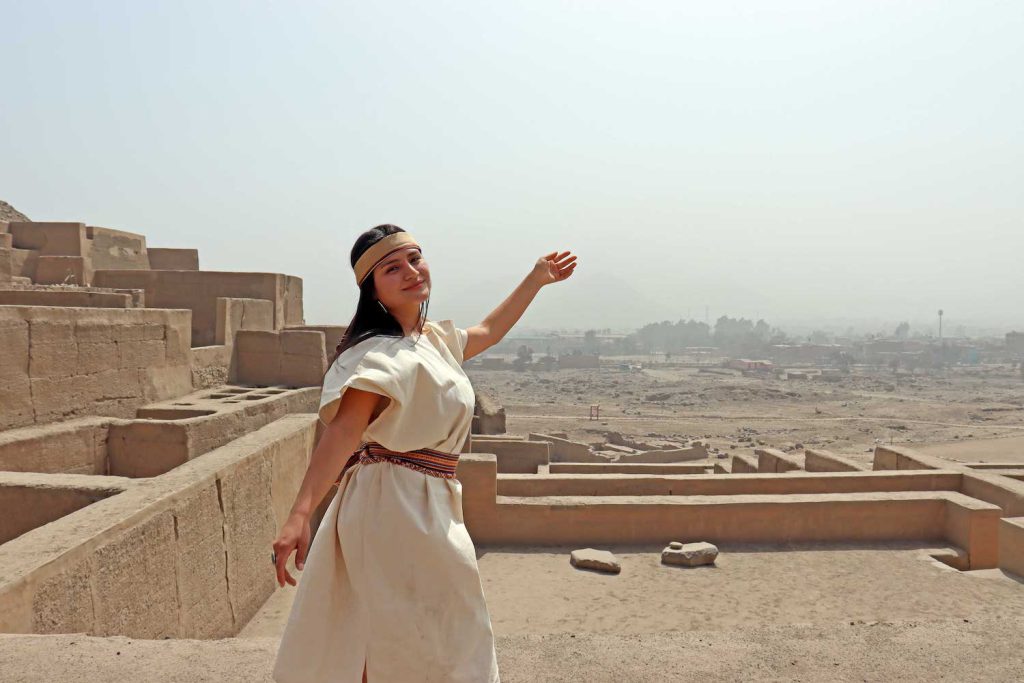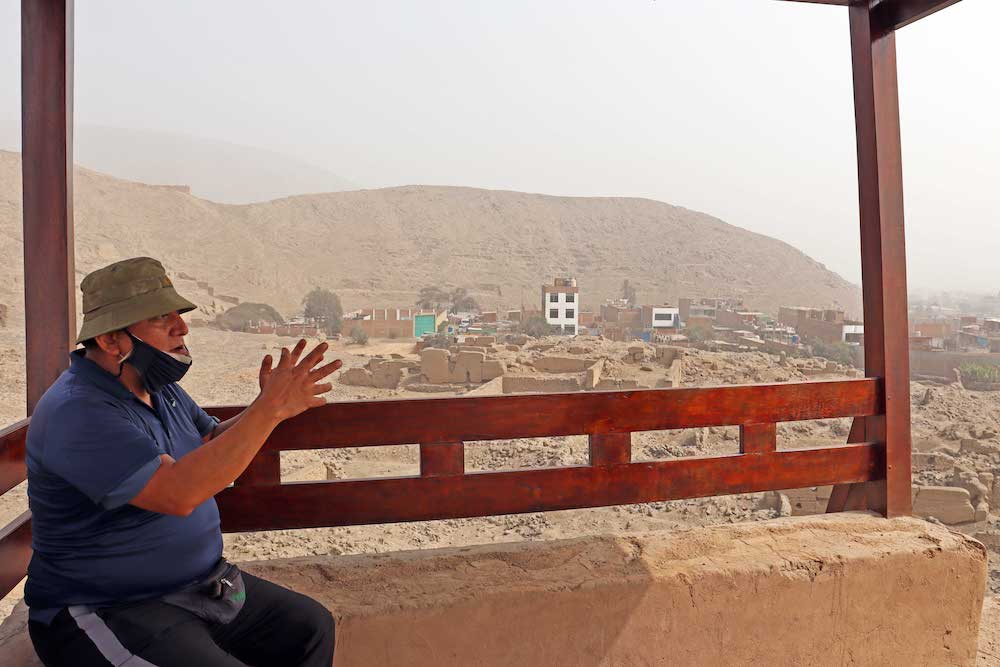Reviving Huaycán—and the Community That Surrounds It

Just an hour’s drive from the center of Lima, Peru, is a palatial architectural complex built of rammed earth and stone. It features labyrinthine passageways, warehouses that once stored foods, and furnished rooms that an Inca emperor—the region’s 15th-century ruler—may have visited.
This site, now called the Monumental Archaeological Zone Huaycán de Pariachi (ZAMHP), has been held by many peoples. Between A.D. 900 and A.D. 1450, these lands belonged to the Ichmas, an ancient society in what is now Peru that flourished on the central coast, and then the Incas, conquerors of the largest territory in the Americas before the arrival of the Spanish.
The archaeological finds on ZAMHP’s 60 hectares include pottery, textiles, funeral bundles, and Incan roads. “We are confronting world history in a single frame,” says physician and physical anthropologist Guido Lombardi.
Visitors today can experience that history in a unique way. Strolling the grounds, they might be welcomed to the huaca, or sacred site, by a young woman wrapped in the elegant yellow robe of a priestess of the Ichmas’ goddess Chaupiñamca, or greeted by a man wearing a tunic and feathered hat, the curaca, or great chief, of the site.
These reenactors are part of a local youth project called Huaycán Cultural. Named for the surrounding community of Huaycán, this small group of passionate people is trying to protect the archaeological site. In the process, they hope to follow the footsteps of other community-led projects in Latin America that have successfully brought economic development by supporting sites with archaeological and touristic appeal.
The work is especially notable in how it draws from and supports a community that has suffered from political neglect and corruption. Huaycán Cultural has offered new opportunities to young residents and built pride in local identity.
In the past, explains Ricky Ramos, a member of the group and an archaeology student at the Federico Villareal National University, “I heard people from Huaycán say that they are not from here.” But that attitude, he notes, is changing as Huaycán Cultural helps people appreciate the area’s history and unique heritage.
As Lucero Solano, another Huaycán Cultural member who studied sustainable tourism at Antonio Ruiz de Montoya University, says, “Thanks to our huaca, I began to look at my community with different eyes.”
Peru’s capital, Lima, and its environs are known for modern buildings and colonial architecture, but the region is also home to more than 400 huacas. Of those, only 27 have been reconditioned and enhanced; most have fallen into disrepair from government neglect.
Perhaps because of this failing, notes Luis Felipe Villacorta Ostolaza, a former vice minister of Cultural Heritage and Cultural Industries in the Peruvian Ministry of Culture and researcher of Ichma and Inca societies, archaeological studies of these sites are limited. “The most important faculties of Peru in archaeology do not have recent publications on the monumental sites of the central coast,” he observes, noting the irony of this fact given the geographic proximity of most of the country’s scholars to these archaeological areas. Villacorta Ostolaza adds that insufficient funding and support mean that the young scholars who work in this region are rarely able to publish papers.
ZAMHP, despite being declared Cultural Heritage of the Nation in 2000, is no exception to these trends. It has received little attention from researchers or the government to date.
In 2013, a US$700,000 project led by the Ministry of Culture set out to improve the site. The plan included enhancements such as new excavations and fencing. But the effort largely floundered due to administrative problems.
That imperfect project, however, inspired Lombardi to organize “The Cultural Talks of Huaycán,” a series of conferences with experts “aiming to prop up the identity and economic development of the community.” In the process, Huaycán Cultural was born. Under Lombardi’s guidance, the group would take the little-known archaeological site and build on its heritage to turn it into a focus of community renewal.
Lombardi, a diligent and kind man, now in his mid-50s, is a researcher at Cayetano Heredia University. He has become a mentor in recent years. He lives in El Descanso, a neighborhood near Huaycán, and envisioned Huaycán Cultural as a collective, engaging local young people to help transform this forgotten jewel into a space of living culture through gatherings, archaeological explorations, and guided tours.
The idea was audacious, however. The site and residents in the community face many challenges. Not only had national leadership neglected ZAMHP, local leaders have also failed ZAMHP. A former mayor denounced for corruption reportedly encouraged illegal land trafficking on ZAMHP grounds. Under the new mayor, people are building houses and digging ditches close to areas of archaeological significance.
Nearby residents in the Self-Managed Urban Community of Huaycán, meanwhile, face difficulties that have made prioritizing archaeological heritage an afterthought. Originally settled largely by migrants from Lima and the Peruvian highlands, the community has many residents who do not have access to basic services such as paved roads.
“There are families without electricity, without water, and living in prefabricated houses or mat huts,” says Sarah Renkert, an anthropologist who has worked in Huaycán. The area’s crime is widely reported by the press, and Huaycán has a reputation as a no-go area, one of Peru’s “red zones” linked to Shining Path terrorist activity in the late 1980s and early 1990s.
Despite these obstacles, Lombardi views ZAMHP as full of potential. To him, the site’s poor management and the damage caused by local corruption signal just how undervalued its archaeological riches are.
“They are suffocating the goose that lays the golden eggs,” Lombardi says. Investing in the site’s preservation, he insists, will ultimately benefit the surrounding community.
The notion that archaeological interest and economic development can work together is sometimes controversial. In many places, conflicts have erupted because site preservation and protection have been seen as incompatible with developing lands in ways that might improve infrastructure or social and economic opportunities.
But archaeologists around the world are discussing ways to positively contribute to community livelihoods while protecting heritage. In Latin America, in particular, several projects explore how preservation and development can go hand-in-hand, provided people find ways to assist and empower the communities that live closest to archaeological sites.
“Thanks to our huaca, I began to look at my community with different eyes,” says Huaycán Cultural member Lucero Solano.
To date, the group has hosted more than 390 cultural talks. Videos of these discussions, which have served as community resources that cover not only archaeology, but also culture and public health, have collectively received tens of thousands of views on the Huaycán Cultural Facebook fan page. About 20,000 people follow the page, which is impressive given that Huaycán itself has a population of roughly 200,000.
Their most popular event is “Un domingo en la Huaca,” a guided, face-to-face tour with characters who interact with the public. This event took place on the first Sunday of each month from 2017 to 2020, until the pandemic paused operations. Before that point, the event was receiving 200 people per day, so many that organizers had to split visitors into small groups and extend visiting hours.
The Sunday visits are scheduled to begin again in May. The majority of tourists came from Huaycán, notes Eduardo Quispe Salcedo, the president and audiovisual producer of Huaycán Cultural, who sees that fact as a special victory for their group.
“Our goal was for the community to know its heritage and develop a sense of belonging,” Quispe says. “And we did it.”
Correction: March 14, 2022
The language in the first sentence of this article was adjusted for greater precision.






























